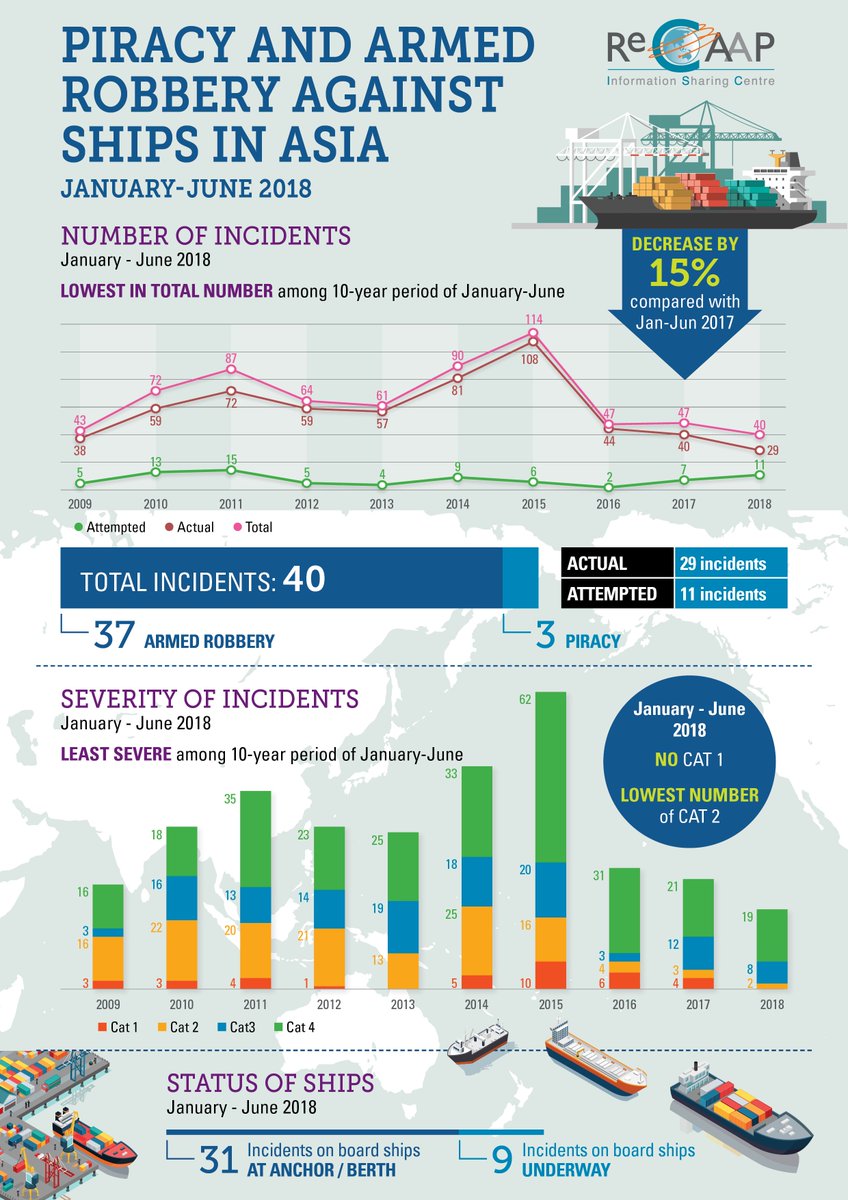ReCAAP ISC Piracy and Armed Robbery Against Ships in Asia - Half-Yearly Report 2018
FORTY Incidents Reported to ReCAAP Information Sharing Centre from January to June 2018, Marking 15% Year-on-Year Decrease, and the Lowest in Number among 10-Year Period of January to June.
ReCAAP Information Sharing Centre (ISC) today released its Half-Yearly (January to June 2018) Report. Highlights of the report, whose information is verified by the respective government agencies, also known as Focal Points, and regional authorities, include:
Overall Summary
- Total of 40 incidents reported from January to June 2018, of which 29 were actual incidents while 11 were attempted cases
- Of the 40 incidents reported, 37 (92%) were armed robbery against ships and three (8%) were piracy
- This marks a 15% decrease compared to the same period in 2017 in the number of incidents reported
- This is also the lowest number among the 10-year period (2009-2018) of January to June
- In terms of severity, there was no Category 1 incident, and two Category 2 incidents, marking the least number of severe incidents since 2009
Areas of Improvement
- There was no actual incident of abduction of crew or theft of oil cargo
- There was a decrease in the number of incidents at ports and anchorages in the Philippines
- There were successful arrests and recovery of stolen items
Areas of Concern
- There was a slight increase of incidents
- In the Singapore Strait (from 2 cases in Jan-Jun 2017 to 4 cases in Jan-Jun 2018)
- At ports and anchorages in Vietnam (from zero case in Jan-Jun 2017 to 2 cases in Jan-Jun 2018)
- One attempted incident of abduction of crew in Sulu-Celebes Seas
- One attempted incident of theft of oil cargo
“Looking back to the number of incidents in 2017 which increased by 16% compared to 2016, the 15% decrease in the first half of 2018 compared to the same period in 2017 is welcome news. Nonetheless, continued vigilance by all stakeholders is an effective deterrence to maritime crime, and we urge heightened measures to be taken in the areas of concern,” said Masafumi Kuroki, Executive Director of ReCAAP ISC.
Insights from Data Analytics
Throughout 2017, ReCAAP ISC embarked on incorporating Data Analytics into its analysis to enhance its information sharing capabilities. Since 2007, ReCAAP ISC has collected the data of over 1,500 incidents of piracy and armed robbery against ships in Asia. These data enable the Centre to conduct deeper analysis on the nature of incidents.
Using Data Analytics, ReCAAP ISC has made analysis, in the Half-Yearly Report, on the main characteristics of incidents at ports and anchorages in Bangladesh, the Philippines and Vietnam as well as incidents on board ships while underway in the Straits of Malacca and Singapore, particularly the Singapore Strait.
Using the Straits of Malacca and Singapore as an example, some of the insights gained from the data of incidents during Jan-Jun period over the last 11 years (2007-2017) were:
In the Straits of Malacca and Singapore
-
Of 122 incidents analysed over the past 11 years, 111 incidents (91%) occurred in the Singapore Strait and 11 incidents (9%) in the Malacca Strait
-
The majority of perpetrators operated in groups of 4-6 men (40%)
-
64% of the perpetrators were not armed/not stated, while 30% were armed with knives/machetes
-
In 83% of the incidents, the crew were not injured/not stated.
In the Singapore Strait
-
More incidents occurred in the western sector than the eastern sector of the Singapore Strait (85 in western sector, 26 in eastern sector)
-
Bulk carriers and tankers were mostly boarded in the eastbound lane of TSS in the western sector
-
Among tug boats/supply vessels boarded in both western sector and eastern sector, relatively more incidents occurred in the westbound lane of the TSS in the western sector
-
There appeared to be a correlation between the types of losses and types of ships:
-
Engine spares tended to be the most common items stolen from bulk carriers and tankers in the eastbound lane of the Traffic Separation Scheme (TSS) in the western sector
-
Cash/property tended to be the most common items stolen from tug boats/supply vessels in the eastbound lane of the TSS in the western sector (northwest of Pulau Batam)
-
Scrap metal tended to be the most common item stolen from barges towed by tug boats in the westbound lane of the TSS in the western sector
-
There appeared to be a correlation between armed perpetrators and treatment of crew in the eastbound lane of the TSS in the western sector; i.e. the more heavily armed the perpetrators, the more violent they tended to be towards the crew.
“At ReCAAP ISC, we are at an initial stage of using Data Analytics to yield insights from our collected data. There is much to learn as we build internal capability in using Data Analytics, and we will continue to do so in order to produce meaningful and useful analysis for our partners and stakeholders in the maritime community,” concluded Masafumi Kuroki.
Source: ReCAAP ISC
OCEANUSLive.org
Information, Security, Safety; Shared
Submitted by Team@oceanuslive.org